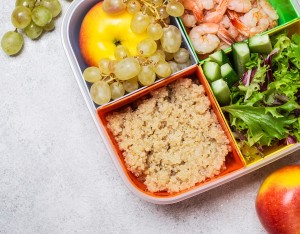Are you looking for efficient ways to achieve and maintain healthy eating habits? Renewed You Plate makes it simple for you!
It’s not necessary to have a perfectly balanced plate at every meal; you can have more protein one meal and less another. Your overall goals should be to have at least one balanced, healthy meal per day and to consume the daily recommendation for each food group by the end of the day. These goals are the key to a more vibrant, energetic and healthy life.
Renewed You Plate is an example of what a balanced plate should look like. (Notice about half the plate is fruits and veggies.) Focus on one meal you’d like to balance, breakfast, lunch or dinner, look at the Renewed You Plate and review the information below to create your meal. Let’s simplify our plates!
- Fruits: Eat in-season fruits in a variety of colors.
- Spring season: avocados, bananas, kiwi, lemons, pineapple, strawberries, and apples
- Aim for 1-2 cups per day. One cup of fruit is equivalent to 1 small apple, 1 banana, 8 strawberries, etc. Add fruit as a side with your meals, or eat it as a snack.
- Example: Spread half an avocado on whole wheat toast. Top with sautéed spinach and 1 sliced hardboiled egg. Sprinkle with salt, pepper and red pepper flakes.
- Vegetables: Eat in-season produce in a variety of colors.
- Spring season: asparagus, mushrooms, kale, cabbage, radishes, broccoli, carrots and Swiss chard
- Aim for 3 cups per day. One cup of vegetables is equivalent to 2 cups of raw leafy greens like spinach or lettuce, 12 baby carrots, 1 cup of most cooked vegetables, etc. Add a different vegetable to each meal.
- Example: Add color to your salads with baby carrots, shredded red cabbage, green beans, broccoli, tomatoes, etc.
- Whole grains: Limit refined grains, such as white bread and white rice.
- At least half of your grains should be whole grains — whole wheat flour, whole oats, brown rice, barley, quinoa, buckwheat, whole grain rye, etc.
- Whole grains contain dietary fiber, B vitamins and minerals. Try to include a source of whole grains in every meal.
- Aim to have 6 ounces of grains per day. An ounce of grains is equivalent to 1 slice of bread; ½ cup of cooked rice, oatmeal, cereal or pasta; and 5 whole wheat crackers.
- Example: Sauté vegetable stir fry with brown rice in avocado oil.
- Protein: Focus on lean meats.
- Eat a variety of protein, including 8 ounces of seafood per week, to increase your nutrient intake. Protein includes poultry, meats, nuts and seeds.
- Grass-fed or organic meat, cage-free eggs and wild-caught seafood are the best.
- Aim for 5 ounces per day. One ounce of protein is equivalent to 1 ounce of meat, poultry or fish; ¼ cup of cooked beans; 1 egg; 1 tablespoon of peanut butter; or ½ ounce of nuts or seeds. Make sure protein is on every plate!
- Example: Make a two-egg vegetable omelet topped with avocado and a small apple.
- Dairy: Focus on healthy options.
- Dairy does not need to be consumed at every meal. Try non-dairy alternatives like unsweetened almond milk or coconut milk. Stick to low-fat milks.
- Aim for 2-3 cups per day. One cup of dairy is equivalent to 1 cup of milk or yogurt and ½ cup of shredded cheese.
- Example: Cook ½ cup of oatmeal with 1 cup of almond milk, and top it with 1 tablespoon of almond butter and some fresh berries.
- Oils and healthy fats: Focus on quality and quantity.
- Olive, coconut and avocado oils are your healthiest oil options. Healthy fats include salmon, olives, avocados, peanuts, almonds, cashews and sunflower seeds.
- Limit or eliminate your intake of canola oil, corn oil and vegetable oil.
- Aim for 5-7 teaspoons of healthy oil per day.
- Sauté, roast or grill vegetables or proteins with 1-2 tablespoons of healthy oil. You can drizzle oils on salads or avocado toast.
Nutritional balance will boost your energy levels, increase your metabolism and improve your overall quality of life. If you don’t have vegetables or fruits with some of your meals, try adding a banana or carrots as a snack. Get back to the basics, and aim for one balanced meal per day.
For more information on specific quantities, visit https://www.choosemyplate.gov/.
By: Alexandra Hoppman

